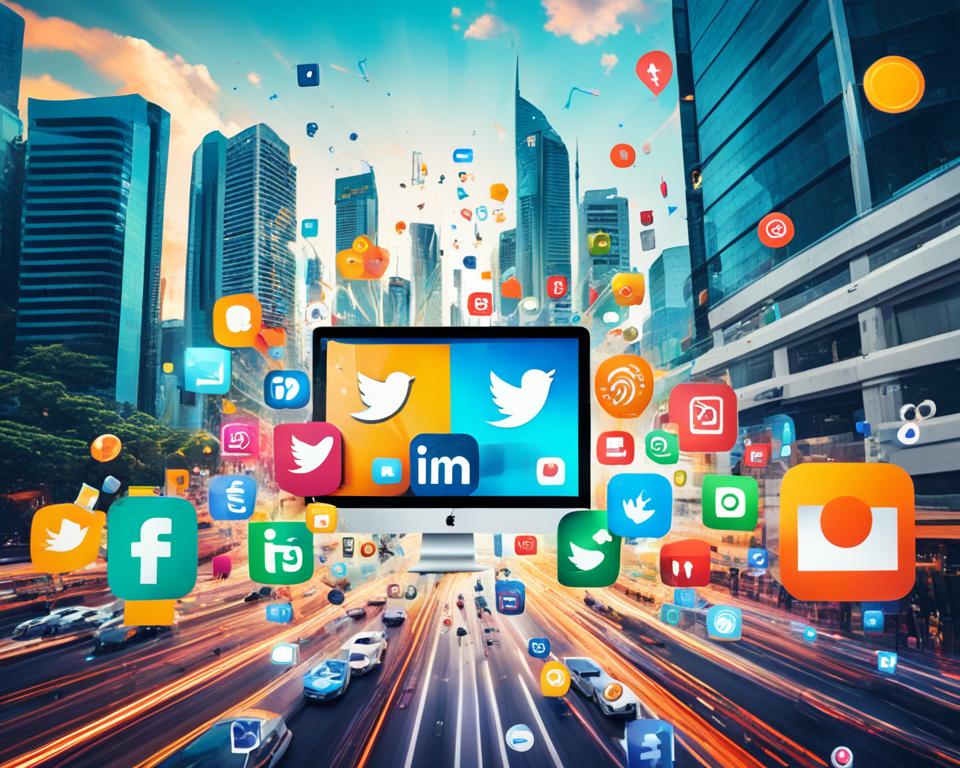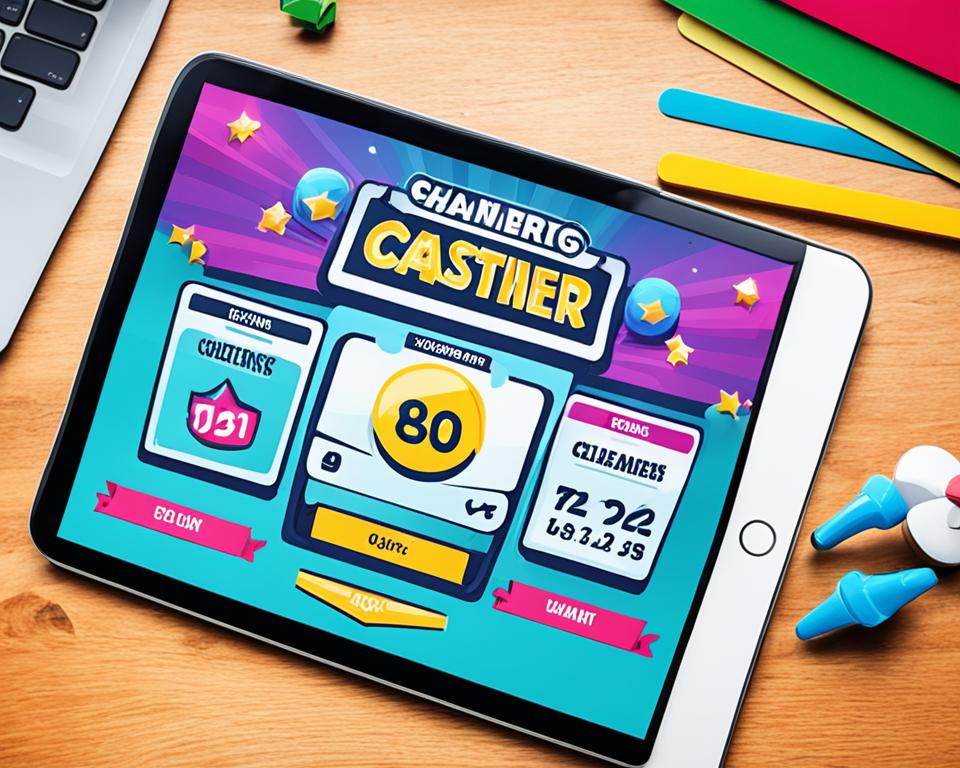In this article, we will explore the potential of gamification strategies in enhancing digital marketing efforts. We will specifically focus on how these strategies can be employed in the competitive landscape of Indonesia.
Gamification is a powerful tool that can revolutionize the way businesses engage with their customers in the digital sphere. By incorporating game-like elements and mechanics into digital marketing campaigns, businesses can create interactive experiences that captivate and motivate their target audience.
Indonesia’s digital marketing scene is thriving, with businesses constantly seeking innovative ways to stand out in this highly competitive market. Through the strategic implementation of gamification, businesses can gain a competitive edge by effectively engaging Indonesian consumers and driving meaningful interactions.
In the following sections, we will delve deeper into the concept of gamification in digital marketing, explore its benefits, examine successful examples, and provide practical tips for implementing gamification strategies in your own digital marketing campaigns.
Join us on this journey as we uncover the untapped potential of gamification in digital marketing and discover how it can elevate your online presence in Indonesia.
What is Digital Marketing?
Digital marketing refers to the promotion and advertising of products or services using digital channels, such as websites, social media, email, and search engines. It encompasses various online marketing techniques to reach and engage target audiences.
Importance of Digital Marketing in Indonesia
In the competitive landscape of Indonesia, digital marketing plays a crucial role in helping businesses effectively reach and engage the Indonesian market. By utilizing various strategies such as social media marketing, search engine optimization (SEO), content marketing, and email marketing, businesses can establish a strong online presence and connect with their target audiences.
Social media marketing is particularly impactful in Indonesia, where a large percentage of the population actively uses platforms like Facebook, Instagram, Twitter, and YouTube. By leveraging these platforms, businesses can increase brand visibility, engage with customers, and drive website traffic.
Search engine optimization (SEO) is another essential aspect of digital marketing in Indonesia. With the proliferation of online searches, businesses need to optimize their websites and content to rank higher on search engine results pages (SERPs). By implementing SEO strategies, businesses can increase organic visibility and attract more targeted traffic.
Content marketing is also an effective tool for reaching and engaging the Indonesian audience. By creating valuable and relevant content, businesses can establish themselves as industry leaders, attract and retain customers, and increase brand loyalty.
Email marketing, although more traditional, remains highly effective in Indonesia. By nurturing leads and sending personalized messages, businesses can build strong relationships with their customers and drive conversions.
The combination of these digital marketing strategies allows businesses to navigate the competitive landscape in Indonesia and effectively reach their target audience. By leveraging the power of social media, optimizing content for search engines, and engaging customers through email and content marketing, businesses can gain a competitive edge and drive success.

“Digital marketing in Indonesia is an essential component of a successful business strategy. By utilizing social media, SEO, content marketing, and email marketing, businesses can effectively connect with the Indonesian market and differentiate themselves in the competitive landscape.”
Understanding Gamification in Digital Marketing
In the rapidly evolving world of digital marketing, businesses are constantly seeking innovative strategies to engage their target audience and drive successful campaigns. One such strategy that has gained traction in recent years is gamification. But what exactly is gamification in the context of digital marketing?
Gamification refers to the incorporation of game-like elements and mechanics into non-gaming contexts, such as digital marketing campaigns. By introducing elements like rewards, challenges, and interactive experiences, gamification aims to enhance user engagement, motivation, and participation.
When applied to digital marketing, gamification provides an opportunity to captivate users’ attention and create a memorable brand experience. By leveraging the principles of game design, marketers can tap into the inherent human desire for competition, achievement, and recognition.
One of the key benefits of gamification in digital marketing lies in its ability to foster a deeper connection between the brand and its target audience. Through gamified experiences, businesses can generate a sense of emotional investment and build long-lasting customer loyalty.
Enhancing User Engagement:
Gamification captivates users by offering interactive and immersive content that goes beyond traditional marketing methods. By providing rewards, points, or badges, businesses can incentivize customers to actively engage with their brand and product offerings.
“Gamification in digital marketing allows businesses to transform mundane tasks into enjoyable experiences, making users more likely to engage and participate.”
Additionally, gamification can be effectively employed to create personalized experiences that resonate with individual users. By utilizing data analytics and user behavior insights, businesses can tailor gamified experiences to address specific customer needs and preferences.
Driving Motivation and Behavior Change:
One of the fundamental principles of gamification is to harness the power of intrinsic and extrinsic motivation. By incorporating elements like challenges, progression systems, and leaderboards, brands can motivate users to take specific actions or adopt desired behaviors.
For example, fitness apps often leverage gamification techniques to encourage users to stay active and achieve their fitness goals. By tracking progress, providing rewards for milestones, and creating social competition, these apps effectively drive behavior change and long-term engagement.
Gamification can also be applied to encourage desired consumer behaviors, such as making purchases, sharing content on social media, or providing feedback. By offering incentives and creating a sense of achievement, businesses can motivate users to actively participate in their marketing campaigns.
Interactive Experiences and Brand Differentiation:
With the increasing noise and competition in the digital marketing landscape, businesses need to differentiate themselves and create memorable experiences. Gamification provides a unique opportunity to stand out by offering interactive and enjoyable brand interactions.
“Gamification allows brands to tell a story, engage users in interactive narratives, and leave a lasting impression that sets them apart from competitors.”
By designing gamified experiences that align with their brand identity and values, businesses can establish a strong emotional connection with their audience. This connection not only enhances brand loyalty but also increases the likelihood of customers advocating for the brand and sharing their experiences with others.
Gamification in digital marketing is a powerful strategy that holds immense potential for businesses looking to boost user engagement, motivate behavior change, and differentiate themselves in the competitive landscape. In the next section, we will explore the specific benefits that gamification can offer to digital marketing campaigns in Indonesia.
Benefits of Gamification in Digital Marketing
Implementing gamification strategies in digital marketing can bring numerous benefits to businesses operating in Indonesia’s competitive landscape. By incorporating game-like elements and mechanics, companies can engage customers, motivate behavior change, foster brand loyalty, and differentiate themselves from competitors.
- Increased Customer Engagement: Gamification creates an interactive and immersive experience for customers, encouraging active participation and longer interactions with digital marketing campaigns.
- Motivated Behavior Change: By leveraging the intrinsic motivation of games, businesses can inspire customers to adopt desired behaviors, such as making a purchase or sharing content with their network.
- Fostered Brand Loyalty: Gamification can strengthen the emotional connection between customers and brands. Through rewards, challenges, and achievements, businesses can foster a sense of loyalty and encourage repeat interactions.
- Differentiation in the Competitive Landscape: In a crowded market, gamification can help businesses stand out by offering a unique and memorable experience. This can lead to increased brand awareness and customer preference.
Gamification in digital marketing is a powerful tool that businesses in Indonesia can utilize to effectively engage customers, drive brand loyalty, and gain a competitive edge.
Achieving Greater Customer Engagement
To illustrate the impact of gamification in digital marketing, let’s explore a real-life example of how Company XYZ successfully implemented gamification strategies in their mobile app.
| Objectives | Mechanics | Results |
|---|---|---|
| To increase app usage and engagement |
|
|
| To encourage social sharing |
|
|
| To boost customer loyalty |
|
|
By gamifying their app, Company XYZ was able to achieve their objectives and create a more engaging and enjoyable experience for their users. This led to increased app usage, social sharing, and customer loyalty.
Implementing gamification strategies in digital marketing is an effective way to captivate and retain customers in Indonesia’s competitive market. By understanding the benefits and leveraging gamification principles, businesses can drive success and achieve their marketing goals.
Examples of Gamification in Digital Marketing
Various businesses have successfully incorporated gamification strategies into their digital marketing campaigns, achieving remarkable results in engaging their target audiences and achieving their marketing objectives. Let’s explore a few inspiring examples of gamification in action:
MCDonald’s: The ‘McDonald’s Monopoly’ Game
“We wanted to boost customer engagement and loyalty while promoting our menu items.”
– McDonald’s Marketing Team
One notable example of gamification in digital marketing is McDonald’s renowned ‘McDonald’s Monopoly’ game. This initiative, inspired by the popular board game, transformed the dining experience into a thrilling contest. Customers received game pieces with their food purchases, each representing a chance to win exciting prizes, including cash, free food, and even dream vacations. By incorporating gamified elements, such as collecting and trading game pieces, McDonald’s successfully enhanced customer engagement, driving repeat visits and brand loyalty.
Sephora: Beauty Insider
“We aimed to create a community of beauty enthusiasts and reward our loyal customers.”
– Sephora Marketing Team
Sephora, a leading beauty retailer, implemented a gamification strategy known as ‘Beauty Insider’ to nurture customer loyalty. The program allows customers to earn points for their purchases, which they can redeem for exclusive beauty products and experiences. By introducing tiers based on spending levels, the program incentivizes customers to strive for higher membership statuses, encouraging increased engagement with the brand and driving customer retention. The gamified rewards system has not only established a sense of community among beauty enthusiasts but also contributed to Sephora’s success in capturing and retaining a loyal customer base.
Gojek: GoPoints
“We wanted to enhance the user experience and incentivize users to engage with the various services offered by our platform.”
– Gojek Marketing Team
Gojek, a popular ride-hailing and super app in Indonesia, introduced ‘GoPoints’ as a gamification tactic to incentivize user engagement. GoPoints is a loyalty program that rewards users with points for utilizing various services within the Gojek ecosystem, such as ride-hailing, food delivery, and entertainment. Users can accumulate points and redeem them for various attractive rewards, including discounts, vouchers, and merchandise. By gamifying the user experience, Gojek encourages users to explore and utilize multiple services, increasing customer retention and loyalty.
Table
| Business | Gamified Campaign | Objective |
|---|---|---|
| McDonald’s | ‘McDonald’s Monopoly’ game | Increase customer engagement and brand loyalty |
| Sephora | ‘Beauty Insider’ rewards program | Enhance customer loyalty and retention |
| Gojek | ‘GoPoints’ loyalty program | Incentivize user engagement and utilization of multiple services |
These examples demonstrate the power of gamification in digital marketing. By tapping into the intrinsic human desire for competition, rewards, and entertainment, businesses can effectively engage their audience, foster brand loyalty, and differentiate themselves in the competitive landscape of Indonesia.

Implementing Gamification Strategies in Digital Marketing
When it comes to digital marketing campaigns, incorporating gamification strategies can be a game-changer. By leveraging the principles of game design and applying them to marketing initiatives, businesses can engage their target audience in a fun and interactive way. In this section, we will delve into the practical tips and steps you need to follow to implement effective gamification strategies in your digital marketing campaigns.
1. Set Clear Objectives
Before diving into gamification, it’s crucial to define clear goals and objectives for your campaign. Ask yourself: What do you want to achieve through gamification? Do you want to increase customer engagement, drive sales, or boost brand loyalty? By setting specific and measurable objectives, you can align your gamification efforts with your broader marketing goals.
2. Define Mechanics and Rules
Next, identify the mechanics and rules that will drive your gamification strategy. Determine which game elements, such as points, badges, leaderboards, or challenges, are most relevant to your target audience and align with your objectives. Make sure your mechanics are intuitive and easy to understand, keeping the user experience in mind.
3. Design Engaging Experiences
Designing engaging experiences is key to the success of your gamification campaign. Create a captivating storyline that hooks your audience and keeps them coming back for more. Consider adding levels, missions, or quests that offer a sense of progression and achievement. Collaborate with designers and developers to ensure your gamified experiences are visually appealing, user-friendly, and accessible across different devices and platforms.
4. Implement Feedback and Rewards
Feedback and rewards play a crucial role in motivating users to participate and engage with your gamification campaign. Provide instant feedback to users’ actions, letting them know how they are progressing and what they need to do to earn rewards. Ensure that the rewards are meaningful and aligned with your objectives, whether it’s exclusive content, discounts, or special privileges.
5. Measure and Analyze Success
Like any digital marketing campaign, analyzing the success of your gamification strategy is essential. Monitor key metrics such as engagement rates, click-through rates, and conversion rates to gauge the effectiveness of your gamified experiences. Utilize analytics tools and user feedback to gather insights and identify areas for improvement. Make data-driven decisions to optimize your gamification strategy and drive better results.
Implementing gamification strategies in your digital marketing campaigns can open new opportunities for customer engagement and brand recognition. By following these practical tips, you can create compelling and memorable gamified experiences that resonate with your audience and drive the success of your digital marketing efforts.
| Benefits of Implementing Gamification Strategies in Digital Marketing | Examples of Businesses Implementing Gamification |
|---|---|
| Increases customer engagement | Company A successfully implemented a gamified loyalty program, resulting in a 20% increase in customer retention. |
| Motivates behavior change | Company B used gamification to encourage healthier lifestyle choices, leading to a 30% decrease in smoking rates among participants. |
| Fosters brand loyalty | Company C implemented a gamified referral program, resulting in a 40% increase in customer referrals and brand advocacy. |
| Differentiates businesses in a competitive landscape | Company D implemented a gamified marketing campaign, standing out from competitors and gaining a 15% increase in market share. |
Remember, implementing gamification strategies requires careful planning, creativity, and a deep understanding of your target audience. By leveraging gamification in your digital marketing campaigns, you can create immersive experiences, drive meaningful engagement, and achieve your marketing objectives in the dynamic landscape of Indonesia.
Conclusion
In conclusion, the incorporation of gamification strategies in digital marketing has the potential to significantly enhance marketing efforts in Indonesia. By integrating game-like elements and mechanics, businesses can effectively engage and motivate customers in this highly competitive landscape, driving success in their online marketing endeavors.
Gamification offers a unique approach to customer engagement by creating interactive and immersive experiences. By providing rewards, challenges, and interactive elements, businesses can capture the attention and interest of their target audience. This not only increases customer engagement but also encourages behavior change and fosters brand loyalty.
In the dynamic and fast-paced world of digital marketing, businesses in Indonesia need creative and innovative strategies to stand out from the competition. Gamification provides a means to differentiate businesses by offering unique and engaging experiences that captivate customers. By implementing gamification strategies in their digital marketing campaigns, businesses can create memorable experiences that leave a lasting impact on their audience.
As the digital landscape continues to evolve, the potential of gamification in digital marketing will only continue to grow. By leveraging the power of game-like elements and mechanics, businesses in Indonesia can create meaningful connections with their target audience, drive customer engagement, and ultimately achieve their marketing goals in the digital realm.
FAQ
What is digital marketing?
Digital marketing refers to the promotion and advertising of products or services using digital channels, such as websites, social media, email, and search engines. It encompasses various online marketing techniques to reach and engage target audiences.
Why is digital marketing important in Indonesia?
Digital marketing plays a crucial role in the competitive landscape of Indonesia. The use of social media marketing, search engine optimization, content marketing, email marketing, and other strategies can help businesses effectively reach and engage the Indonesian market.
What is gamification in digital marketing?
Gamification involves incorporating game-like elements and mechanics into non-gaming contexts, such as digital marketing campaigns. This strategy aims to enhance user engagement, motivation, and participation through the use of rewards, challenges, and interactive experiences.
What are the benefits of gamification in digital marketing?
Implementing gamification strategies in digital marketing can offer several benefits. It can increase customer engagement, motivate behavior change, foster brand loyalty, and differentiate businesses in Indonesia’s competitive market.
Can you provide examples of gamification in digital marketing?
Various businesses have successfully used gamification in their digital marketing campaigns. We will explore case studies and examples of how companies in Indonesia have implemented gamification to achieve their marketing objectives.
How can I implement gamification strategies in my digital marketing campaigns?
This section will discuss practical tips and steps to implement gamification strategies in digital marketing campaigns. We will cover aspects such as setting objectives, defining mechanics, designing experiences, and measuring success.
Conclusion
In conclusion, gamification has the potential to significantly enhance digital marketing efforts in Indonesia. By incorporating game-like elements and mechanics, businesses can engage and motivate customers in this competitive landscape, ultimately driving success in their online marketing endeavors.




